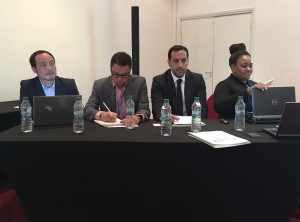Linking NDCs and NAMAs in the Transport Sector
 On November 13th GIZ and CCAP hosted a session that took a good look at the challenges and needs for support in implementing ambitious transport mitigation actions that are also consistent with NDCs and sectoral action plans. Urda Eichhorst, Transport Advisor at GIZ, and Laurence Blandford, CCAPs Director of International Policy, moderated the event, titled “Towards implementing the Paris Agreement in the transport sector: Linking NDCs and NAMAs”. The session was part of SLoCaT’s Transport Day in Marrakech back to back to the 22nd United Nations Climate Conference (COP22).
On November 13th GIZ and CCAP hosted a session that took a good look at the challenges and needs for support in implementing ambitious transport mitigation actions that are also consistent with NDCs and sectoral action plans. Urda Eichhorst, Transport Advisor at GIZ, and Laurence Blandford, CCAPs Director of International Policy, moderated the event, titled “Towards implementing the Paris Agreement in the transport sector: Linking NDCs and NAMAs”. The session was part of SLoCaT’s Transport Day in Marrakech back to back to the 22nd United Nations Climate Conference (COP22).
The invited speakers were all from countries highlighting transport in their national climate action plans (so called Nationally Determined Contributions, short NDCs) and implementing transport NAMAs. They described the lessons they had learned from NAMA preparation and implementation, as well as how these NAMAs currently integrate with their countries’ NDCs and to what extent NAMAs are reflected in NDCs or not. The speakers were:
- Mr. Agustín Encina Pérez, Vice Minister, Paraguay Ministry of Transport
- Mr. Giovanni Pabon, MADS Colombia on TOD NAMA and links to its NDC
- Mr. Themba Tenza, DoT South Africa on South Africa’s NDC and NAMAs
- Mr. Vu Hai Luu, MoT Vietnam on Vietnam’s low carbon bus NAMA and NDC
The speakers emphasized the importance of transport to their domestic mitigation efforts and reflected on the long-term transformation required. This necessitates a good understanding of transport related emissions. In Viet Nam GIZ is working with the Ministry of Transport to develop a detailed transport emission inventory that will serve as the basis for an analysis of the transport mitigation actions outlined in the NDC. Based on the NDC Viet Nam developed its first transport NAMA proposal submitted to the NAMA Facility on October 31st. In other cases, NAMA development has been important for understanding potential transport GHG mitigation opportunities and NDC development. In Colombia, analyses for various NAMAs, along with other studies, helped inform the country’s INDC and evolving low-carbon sector strategy. In South Africa, top down climate policies and goals helped the transport sector identify the strategic priorities within which its own reduction efforts would be anchored.
The country speakers were followed by Ms. Elisabeth Windisch, Ricardo Energy & Environment who discussed how to overcome challenges for transport sector integration in NDCs, highlighting in particular the need to help countries access better data, the importance of accurately evaluating co-benefits to make the case for transportation investments, and the need for inclusive NDC development processes so that sector stakeholders could inform choice made and feel buy-in for their implementation. In the following discussion coordination between implementing agencies and environmental agencies for effective MRV of the NDCs and NAMAs was highlighted. Especially understanding what kind of co-benefits result from transport mitigation actions can help to create win-win situations that lead to transformational change. However, further provision of technology and financial support to developing countries will be necessary to ensure that developing countries are empowered to make ambitious, long-term decisions in line with their national circumstances and sustainable development goals.
